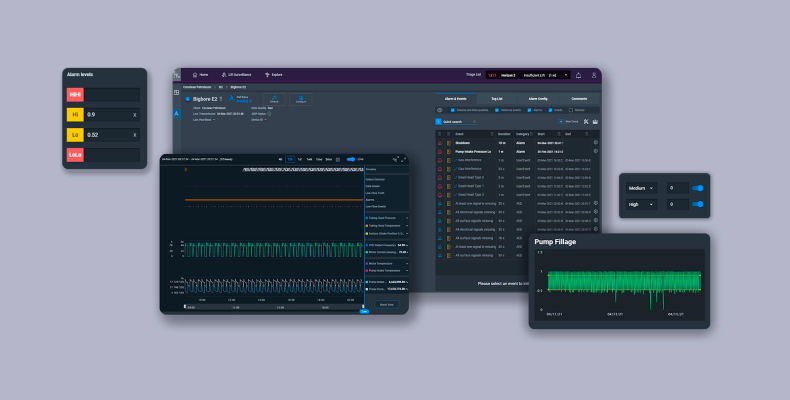We use cookies to ensure we give you the best experience on our website. By clicking Agree you accept our Privacy and Cookies Policy.
How to choose asset management software for oil and gas in 2026

 12 minutes read
12 minutes read
Content
Are you a business owner looking for oil and gas asset management software that meets all the oil & gas industry needs in 2026? Making the right decision requires a great deal of research & knowledge.
The oil and gas industry is undergoing a significant digital transformation, and at the heart of this evolution lies the critical need for robust asset management. In 2026, selecting the right asset management software is no longer just about efficiency; it’s about safety, compliance, and maintaining a competitive edge. This guide will delve into the key considerations for choosing asset management software, incorporating insights from top industry players to help you make an informed decision.
Fortunately, we are here to help you make smart decisions about what to invest in. In this article, we’ll provide insight into which oil and gas asset management solutions will give your company the best returns in 2026.
The power of digital transformation in oil and gas
The oil and gas industry has always been known for its complex operations and challenging work environments. However, with the advent of new technologies, it has become possible to automate many of the business processes, making them faster, more accurate, and cost-effective.
Business process automation is a game-changer in the oil and gas companies, offering numerous benefits that revolutionize the way companies operate. For example, automating the procurement process can reduce the time and effort required to search for the right vendors and negotiate contracts. It can also improve inventory management, allowing companies to optimize stock levels and reduce waste.
On top of that, modern software protects your sensitive data and systems from security breaches. Cybersecurity threats are a significant concern in the oil and gas industry, as they cause disruptions in operations and lead to safety and environmental risks. That’s why switching to top-notch oil and gas data management software with built-in security features is not a luxury – it’s a necessity.

Types of asset management software for oil and gas
There are several types oil and gas software for asset management, each meeting a specific business purpose. Let’s make a brief overview of them, so you can better uderstand what exactly you need for your company.
Fleet management software
This type of software is great for managing such assets as vehicles and equipment. It offers features that allow users to track the location and status of their assets in real-time, provide maintenance alerts and reminders, optimize fuel utilization, and document safety compliance records.
Production planning software
This solution helps companies maximize their production by enabling them to plan and manage the entire production process. With oil and gas software, you can create, simulate, and optimize plans for drilling operations, manage wellhead data in real-time, track personnel assignments and equipment utilization rates, identify potential bottlenecks in the production process, generate custom reports on key performance metrics, and more.
Logistics management software
By using logistics management software, businesses can manage their operations with greater efficiency as they have a comprehensive view of materials and resources in the supply chain. It enables users to monitor delivery times and identify potential bottlenecks in the logistics process. With oil and gas land management software, you can create custom reports for key performance metrics, reduce paperwork, and more.
Safety compliance software
Safety compliance software helps users track and manage safety protocols, providing them with visibility into potential hazards in their operations. This software also helps oil and gas companies to stay on top of safety regulations as it provides automated alerts when changes occur, allows to document safety compliance records and audits, and more.


Interested in a tailored asset management solution for your oil and gas company?
Contact us to explore the possibilities.
At Blackthorn Vision, we could consult you on any type of software mentioned above. Just get in touch with us to learn more about advanced oil and gas technologies.

What to choose: off-the-shelf product or custom asset management system?
When it comes to finding the right software solution for your oil and gas business, you have two main options: off-the-shelf or custom solutions. Both options have their own set of pros and cons, and it’s important to understand them before making a decision.
Off-the-shelf products
Off-the-shelf products are pre-built software solutions that can be purchased and implemented by oil and gas companies to manage their assets.
Pros:
- Quick and easy to implement since the setup process is generally straightforward.
- Cost-effective, vendors often provide services such as installation, training or support.
- High level of reliability with built-in features that have been thoroughly tested and proven to work.
Cons:
- Limited customization options which may not meet your specific requirements.
- Standard updates may be out of sync with changing needs or growing business demands.
- Difficult to integrate with existing software systems and third-party applications.
Off-the-shelf products have several advantages, including quick and easy implementation, cost-effectiveness, and high reliability due to thoroughly tested built-in features.
However, there are also some drawbacks to consider, such as limited customization options, standard updates that may not align with changing business demands, and difficulty integrating with existing software systems and third-party applications.
Custom solutions
This type of solution is tailored to the specific needs of each company, taking into account factors such as the type of assets being managed, the size and complexity of operations, and the regulatory requirements that must be met. Obviously, costum products also have positive and negative aspects explained below.
Pros:
- Completely tailored to your exact requirements and specifications.
- Fully integrated with existing software systems and third-party applications.
- Easily adaptable to changing needs or growing business demands.
Cons:
- Longer implementation process with more resources and time required.
- Higher cost due to the need for ongoing customization, maintenance and training.
Custom software solutions have several advantages, including being tailored to the exact specifications, full integration and easy adaptability. At the same time, drawbacks include longer implementation processes that require more resources and time, and higher costs.
So what to choose?
Summing up, off-the-shelf products are pre-built software solutions that can be quickly implemented, while custom solutions are tailored to your specific needs.
Off-the-shelf oil and gas accounting software may be suitable for businesses that require quick and easy implementation, cost-effectiveness, and high reliability. However, if your business has specific requirements that cannot be met by standard software, you may face limited customization options and difficulty integrating with existing software systems and third-party applications.
On the other hand, custom software solutions may be more suitable if you have complex operations and require tailored features to meet specific regulatory requirements. Custom software solutions also provide full integration and easy adaptability to changing needs or growing business demands. However, these solutions require longer implementation processes, more resources, and higher costs.
However, you don’t always have to start from scratch. With the power of modern technology, you can upgrade and modernize your existing software to take it to new heights. More about it below.
Key considerations for choosing asset management software
When evaluating asset management software for your oil and gas operations, several key factors should be at the forefront of your decision-making process. Our analysis of leading solutions highlights the following crucial aspects:
1. Real-time asset tracking: gaining unprecedented visibility
In the oil and gas industry, assets are often dispersed across vast geographical areas, making real-time tracking a necessity. The ability to monitor the location and status of critical equipment, pipelines, and even personnel in real-time offers significant advantages:
- Enhanced Security: Quickly identify unauthorized movement or potential theft of valuable assets.
- Improved Safety: Track personnel in hazardous zones, monitor their well-being, and respond swiftly in case of emergencies.
- Optimized Logistics: Efficiently manage the movement and deployment of equipment, reducing delays and improving resource allocation.
- Data-Driven Decisions: Gain insights into asset utilization, identify bottlenecks, and optimize operational workflows.
Leading solutions leverage technologies like RFID (Radio-Frequency Identification), GPS (Global Positioning System), and various sensors to provide this real-time visibility. Consider software that offers seamless integration with these technologies to gain a comprehensive view of your asset landscape.
2. Comprehensive maintenance management: proactive strategies for optimal performance
Downtime in the oil and gas industry can lead to significant financial losses and potential safety hazards. Effective maintenance management is therefore paramount. Look for software that supports a range of maintenance strategies:
- Preventative Maintenance: Schedule regular maintenance tasks based on time or usage intervals to prevent failures.
- Predictive Maintenance: Utilize data analytics and sensor information to anticipate potential equipment failures and schedule maintenance proactively, minimizing unexpected downtime.
- Condition-Based Maintenance: Trigger maintenance activities based on the actual condition of the asset, as determined by sensor readings and real-time monitoring.
A robust asset management system should facilitate work order management, asset history tracking, maintenance scheduling, and resource allocation, ultimately improving asset reliability and extending its lifespan.
3. Ensuring safety and regulatory compliance: a non-negotiable priority
The oil and gas industry operates under strict regulatory frameworks. Your asset management software should play a vital role in ensuring compliance and enhancing safety:
- Tracking Safety Certifications: Manage and track the certifications and qualifications of personnel and equipment.
- Work Permit Management: Streamline the process of issuing, tracking, and managing work permits to ensure adherence to safety protocols.
- Environmental Monitoring: Track environmental performance indicators and ensure compliance with environmental regulations.
- Audit Trails and Reporting: Maintain comprehensive records of all asset-related activities for audit purposes and regulatory reporting.
Choosing a solution with built-in features for safety and compliance management can significantly reduce risks and streamline regulatory processes.
4. Understanding different types of asset management software: EAM vs. CMMS
When exploring asset management solutions, you’ll likely encounter terms like Enterprise Asset Management (EAM) and Computerized Maintenance Management Systems (CMMS). Understanding the difference is crucial for selecting the right fit for your needs:
- EAM Software: A more comprehensive solution that manages the entire lifecycle of an asset, from acquisition to disposal. It typically includes features for asset tracking, maintenance management, procurement, finance, and project management. EAM systems are well-suited for organizations with complex asset portfolios and a need for integrated management across different departments.
- CMMS Software: Primarily focused on maintenance management. It helps organizations plan, schedule, and track maintenance activities, manage work orders, and maintain asset history. CMMS solutions are often a good starting point for organizations primarily focused on optimizing their maintenance operations.
Consider your organization’s size, complexity, and specific needs when deciding between an EAM and a CMMS solution.
5. The importance of modernizing legacy software
Many oil and gas companies still rely on outdated legacy systems for asset management. Modernizing this software is crucial for unlocking significant benefits:
- Improved Efficiency and Productivity: Modern systems offer streamlined workflows, automation capabilities, and user-friendly interfaces that enhance productivity.
- Enhanced Data Accuracy and Visibility: Modern solutions provide real-time data and comprehensive reporting capabilities, enabling better decision-making.
- Stronger Security and Compliance: Updated software incorporates the latest security protocols and helps ensure compliance with evolving regulations.
- Better Integration Capabilities: Modern systems can seamlessly integrate with other enterprise applications, providing a holistic view of your operations.
Consider the long-term benefits of modernizing your asset management software to gain a competitive advantage and optimize your operations.
Is modernizing your legacy software worth it?
When it comes to choosing the right software for your oil and gas business, you may feel stuck between two options: off-the-shelf or custom software. However, there is another option that can provide significant value to your business: modernization of existing solutions. Modernizing existing software solutions in the oil and gas industry can bring numerous benefits to businesses, including:
- Cost savings. Modernizing an existing software system can be more cost-effective than building a new one from scratch. This can be especially important for oil and gas companies that may be facing budget constraints.
- Increased efficiency. Upgraded software can lead to increased efficiency in operations and processes, allowing companies to streamline workflows and improve productivity.
- Enhanced safety. By modernizing safety-related software, oil and gas companies can ensure that their operations meet the latest safety standards and regulations.
At Blackthorn Vision, we have deep knowledge and expertise in application modernization. Our team can work with you to identify areas of improvement, implement new functionality, and enhance the overall user experience.
Our team has a proven track record of successfully creating and improving legacy software for the oil and gas companies. For example, we recently helped Sensia upgrade their existing web-based application, adding new functionality and making the customer experience even greater.
So whether you need a new software system developed from scratch or an existing one modernized, we have the capabilities to tackle even large enterprise-level projects. Our team of skilled developers and engineers can work with you to identify your specific needs and create a tailored solution that helps you achieve your business goals in the oil and gas industry.

Summing up: the best oil and gas asset management software in 2026
The oil and gas industry is rapidly evolving and embracing new technologies to increase efficiency and reduce costs. Software development plays a vital role in this evolution, providing innovative solutions that enhance exploration, production, and distribution processes.
Choosing the right asset management software is a critical decision for oil and gas companies in 2026. By considering factors like real-time tracking, comprehensive maintenance management, safety and compliance features, the type of software (EAM/CMMS), the choice between off-the-shelf and custom solutions, and the importance of modernizing legacy systems, you can make an informed decision that will drive efficiency, safety, and success in your operations.
At Blackthorn Vision, we understand the importance of staying ahead of the curve in this dynamic industry. Our oil and gas software development services are designed to help you leverage cutting-edge technologies to achieve your goals. Whether you need customized software solutions or integration with existing systems, our team of can deliver results that streamline your operations and boost your bottom line.
Don’t let your competitors gain the edge. Contact us today to learn more about our services and take the first step towards a more efficient, profitable future.







































































